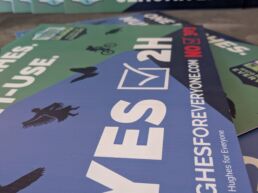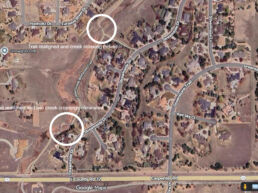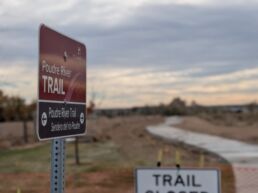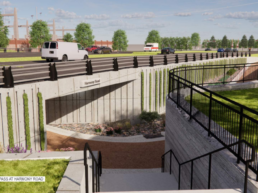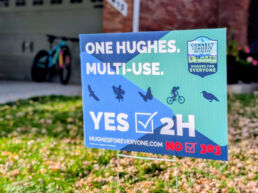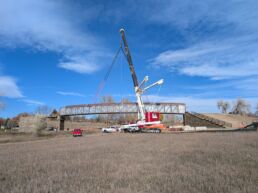
Scrolling the internet, especially Facebook, you’ll find a lot of information and misinformation on who’s doing what to our trails. It’s hard to tell who’s doing what, where and why. As the largest and most visible trail advocacy group in the area, the Overland Mountain Bike Club takes a lot heat for things they may or may not have had anything to do with, or if they did have something to do with it, their input on the design may have been very limited. Recently, YGR caught up with Kenny Bearden, the Executive Director of OMBC and had a virtual sit-down to see if we couldn’t clear the air a bit.
YGR: Tell us what Overland’s mission statement is?
Kenny: Promote the active, healthy sport of mountain biking by providing education and assistance to all trail users, and by working to build and maintain quality, sustainable trails that enhance the mountain biking experience.
YGR: Do you have a trail building philosophy?
Kenny: Good question. We’ve never really discussed or come up with a “trail building philosophy” as an organization. We take each project independently. But, the goal of every project is summed up in our mission statement – “…build and maintain quality, sustainable trails that enhance the mountain biking experience.” One thing not included here but is followed with every project is that we do look at the intended user groups and targeted ability levels. What we did on the alt-line at Michaud is much different than what we laid out for Hidden Valley at Devil’s Backbone.
YGR: How much say do you guys have in the actual design of a trail? Does it depend on the land agency?
Kenny: It depends on the agency and the project. Until the last couple years, it wasn’t much. This is when OMBC began hosting multiple trail building training classes. We’ve been fortunate to have trail crews from several agencies attend, so they are seeing the benefits of the high-quality multi-use trail design standards we are teaching and asking for. In most cases, the trail crews themselves don’t always have complete authority either. It’s dependant on higher levels within the agencies.
We’ve had a lot more input on recent projects. For Young Gulch, Limber Pine Trail at Hermit Park and the Hidden Valley Trail at Devil’s Backbone, OMBC was able to help lay out the initial flag line. The very basic process for a new trail is 1) identify all areas you have to avoid due to wildlife, habitat, cultural & historical concerns, 2) identify the feature areas you want the trail to pass through (views, rock features, etc), 3) identify and approve a corridor (ex. 100’ wide path inside of which the trail will be routed), 4) lay out the exact flag line for which the trail will follow (setting pin flags about every 5-10’), 5) create construction notes for all trouble spots, feature locations, etc, 6) begin construction, and 7) adjust as needed during construction. Historically we’ve been brought in around step 5 or 6 in this process. We want to be involved from before step 1. Currently it varies and tends to be somewhere between 2 and 4.
Again, the above is just in general. Some projects we’re not involved except for looking at an established flag line and being allowed to offer input/suggestions, while others we’re helping lay out the initial flag line within an approved corridor. There are a couple where we’ve been able to adjust the corridor based on our involvement.
Another issue is that some agencies are hesitant to allow us to provide too much input because they don’t want to cater to a single group. The problem with that is very few other groups have the overall level of knowledge and experience in multi-use trail design and construction as Overland. When we do a site review with multiple user groups attending, it’s generally Overland providing suggestions and identifying the positives and negatives with the layout, while the other attending groups tend to observe and agree. Another challenge is that some groups look for an easier build, not a better trail. We want the best trail we can possibly get in each location for mountain biking.
YGR: Give us a little history on OMBC?
Kenny: A little history??? …been around for 22 years…started small by an awesome group of dedicated & passionate individuals…now not so small…still have an awesome group of dedicated & passionate individuals.
YGR: How many members do you have now?
Kenny: 411 according to the current IMBA records. For a little comparison to other groups in CO…RFMBA in Aspen and the Roaring Fork Valley is about the same size, BMA in Boulder is about 1000ish, COMBA in Denver is around 1400.
This identifies something OMBC has got to do a better job of, and that’s being better at communicating and showing why it benefits not just you individually to join, but also how/why it helps the overall riding community. Decision makers pay attention to numbers. If you go to a land manager as an individual asking for a new trail or something to be done, they’re going to listen to you and thank you for your input. Probably not much happens beyond that. If you go to the same land manager representing 200 people, they’re likely to listen a bit more. If you go to the same land manager representing 1000 active trail users, you’re going to have their attention.
YGR: You recently became the local IMBA chapter. How has that changed the club?
Kenny: It hasn’t changed much. We’re hoping to tap into a few new funding opportunities. Total membership has increased, but no change at all in how the club operates. Unfortunately for us, we rolled into the IMBA Chapter Club program at really the absolute worst time possible. About a month after our transition, IMBA lost their primary financial sponsor (Subaru), their Executive Director, the CO/WY Region Director and probably more than half of their overall staff within a few additional months. The Chapter Club program as a whole then began a complete overhaul, which is still being pieced back together. We’re seeing the light at the end of the tunnel and are hopeful the new program will be solidified by the first of the year, with some major upgrades.
YGR: Was there any resistance to joining IMBA?
Kenny: Not much.
YGR: You guys take a lot of heat for ‘trail improvements’ that take place in the area. Let’s clear the air. What projects have you guys been involved in recently?
Kenny:
2017:
-
the new alt line on the lower section of Michaud/Reservoir Ridge/Foothills Trail
-
rock armoring a couple sections of Michaud/Reservoir Ridge/Foothills Trail primary trail tread
-
Young Gulch rebuild
-
Limber Pine Trail at Hermit Park
-
Spring Canyon Bike Skills Park
-
lower Mill Creek in Lory (starting 9/14)
2016:
-
Young Gulch
-
Limber Pine Trail at Hermit Park
-
Spring Canyon Bike Skills Park
-
Hidden Valley Trail at DBB
-
West Valley in Lory – filling in of highly cupped trail sections
2015 & prior:
-
rebuilding several turns on lower Sawmill and improving drainage/armoring
-
lots of work at Gowdy – developing multiple play areas, re-routed section of Mo Rocka, new Rockin B trail, sections of Stone Temple
-
re-route of Shoreline section of Foothills Trail after part of it collapsed into the reservoir
-
East Valley in Lory – rebuilding sections of highly cupped trail
-
the alt line on lower Sawmill in HMOS (1 section completed – 5 additional sections that we haven’t yet been allowed to build)
-
improving flow and sustainability of east South Valley Trail in Lory
-
re-route section of the A-trail where it intersects with upper Maxwell
-
Hewlett Gulch re-route of the old “asteroid belt” section
YGR: Alright, perhaps more importantly, what have you NOT been involved?
Kenny:
-
ramping of the Shoreline stairs
-
current work on Howard Trail in Lory
-
building of the Shoreline Trail in Lory
-
smoothing over of the rock section of Blue Sky
-
recent work at Hewlett Gulch
-
any other work at Michaud/Reservoir Ridge not specifically listed above
I have no idea what other projects have been done in the area since there are so many trails and different groups working on them. Any given day there is a group out there working on something. If there is something in question I encourage people to reach out and ask us.
YGR: Has there ever been a trail improvement/repair that you had to make that went against your better judgement?
Kenny: There has. The layout of the Hewlett Gulch re-route was an issue for us. The constant work on the East & West Valley Trails at Lory SP is always an issue. Until these trails are brought a little higher up on the hillside, there will always be drainage and cupping issues.
YGR: What have you guys screwed up?
Kenny: The biggest thing we’ve screwed up is not being clear about what we’re working on. We have always made a point of talking about how much trail work we do. So when people see work being done they assume it must be Overland. There are a lot of different groups out working on trails.
This brings up another area we could have done better…cooperation and communication with other groups. When Larimer County Horsemen’s Association goes out and works on a trail, they are working on it from an equestrian perspective. When Poudre Wilderness Volunteers works on a trail, they are working on it from a hiker perspective. Same with an MTB group. When all these different groups work on different sections of the same trail, the overall character and flow suffers. We have become much more successful recently at building these effective partnerships and getting agreement on project details and new proposal ideas. This works better for all trail users, not just mountain bikers.
YGR: What do you wish people understood about repairs in the area?
Kenny: Probably the biggest thing is that we don’t have a single mountain bike trail in this area. Everything we currently have are multi-use trails. Repairs aren’t made for mountain bikers…they’re made considering ALL trail users – hikers, trail runners, mountain bikers and equestrians.
Repairs are not being done to change the overall ability levels of any trail. In fact, most land agencies don’t consider a targeted ability level of mountain bikers, hikers or equestrians when building trails. They are focused on building/maintaining a sustainable trail that fits into the terrain in which it is built and minimizes impacts to wildlife, ecological and cultural/historic resources. User safety is equally important. That’s the agency perspective.
From our perspective, repairs are done to minimize and restore impacts from erosion while maintaining or improving the fun factor for users and maintaining the character of the original trail. But again, it really depends on the individual project.
YGR: What do you wish people understood about trail construction in the area?
Kenny: I typically hate doing this, but I’m going to answer a question with a question…how many people reading this actually know how many different land agencies we deal with in this area? How many people actually know what trails are maintained by what agency? What agency manages Rim Rock? Blue Sky? Coyote Ridge? Foothills Trail? East Valley Trail? How many know that to get a new trail approved on the east side of Lory it takes approval from THREE different agencies? …Lory State Park, Larimer County Natural Resources and Bureau of Reclamation.
Fort Collins Natural Areas and Larimer County Open Lands manage the majority of trails in the immediate area, each with about 90-110 total miles of trail. But neither agency has recreation as a priority area of focus. Land preservation and natural resource protection are the primary focus.
And the answer to my first question above is 7 – FC Natural Areas, FC Parks, Larimer County Parks, Larimer County Open Lands, CO Parks & Wildlife, City of Loveland Parks & Open Spaces and the US Forest Service. Actually, 8 – forgot about Bureau of Reclamation. OMBC also works with WY State Parks north of the border.
YGR: How can people help OMBC?
Kenny: Multiple ways. The 3 primary ways are financial donations, membership and volunteering.
Trails cost money. OMBC needs funding to continue pushing existing and future new trail proposals. The more funds we can raise, the more we can assist with new projects…and the faster we can get them completed and open for riding. Volunteer built trails take a LONG TIME to build. Young Gulch will end up taking nearly 4 years for a roughly 4.7 mile trail. Limber Pine Trail at Hermit Park will take 2 years for a roughly 6.5ish mile trail, which also includes paid seasonal trail crews. A professional trail building company could be hired to complete these projects significantly faster. But, the cost will also increase to roughly $5-6/lineal foot, or about $30,000 per mile. And this is just construction costs. Adding in initial planning, scouting, proposal development, etc and the cost goes up even higher. OMBC is looking at multiple proposals over the next couple years totaling 60-70 miles or more of new trail. I’ll let you guys do the math, but that’s some serious dollars. One way to look at it is “how many feet of new trail can you help support?”
As mentioned above, joining OMBC also helps. We currently receive on average about $20 per member after our split with IMBA. We’re hoping this will increase to about $30 per member starting 2018 due to the new IMBA chapter program. Our costs per member in swag and member benefits are about $20 as well, so we have a net of basically $0 from membership dues. Membership helps with engagement with land agencies, sponsorship requests to local companies, and provides a larger pool of resources.
Volunteering for events and trail projects is an obvious need. We can get a helluva lot more work done with 100 volunteers than we can with 50. The more volunteers we get, the more trail projects we can complete. Trail volunteers are always needed. An equally important need is for trained crew leaders to lead these volunteers. OMBC offers an annual Crew Leader Training Class. Again, the more crew leaders we have, the more crews we can have out working.
Ideally, we have people joining as members, volunteering on projects and making cash donations. Some can’t make the volunteer days so they make cash donations instead…but still join as members. Others can only do 1 of the 3…and it all helps!
YGR: How can people help get more trails in the area?
Kenny: Best way for people to help get more trails in the area – pay attention to announcements for public open house and online commenting/surveys…and participate. Make your voice heard. OMBC makes announcements on Facebook and in our newsletters about each of these that relate to new trail opportunities. If you’re not getting our newsletters, go to http://overlandmtb.org and sign up. You don’t have to be member to sign up for the newsletter. Contacting city and county leaders and asking for better natural-surface trail connectivity and options can help. County commissioners, city council members, mayor’s office, etc are always interested in hearing from their constituents, so reach out and let them know what you want and why.
The other way is to donate. The financial aspect is hugely important, obviously.
What doesn’t work is going to an agency and simply saying “you know, you guys should really put a trail here…” (unless you’re Dan Porter asking for a CX course). At the very least a comprehensive project proposal is needed to address the trail corridor, who will build it, how it will be funded, project timeline, impacts to the resource, targeted user groups and what need does it fill. This is where a group like OMBC makes a difference. With our pool of resources, we can create effective proposals with the history to follow through. More likely, however, any new trail that is approved needs to be included in the agency’s management plan for that specific property or its overall master plan. Again, a well-timed, well-researched and comprehensive proposal is the best chance for adoption into a management plan.
YGR: A lot of people are frustrated because they feel their voices aren’t heard when it comes to new trails and trail improvements. What can they do to voice their opinion?
Kenny: Provide your input at open houses or in online surveys. Show up to volunteer projects. Figure out who you want to be heard by and approach them. Join OMBC and get on the Trails Committee. Create and submit your own trail proposal…or bring it up to myself or our Trails Committee. We certainly don’t have all the answers and are always happy to hear new ideas.
Another option is to approach any of the other groups on NoCo TAG (Trails Advocacy Group). This is a collaboration of mtb, trail running and equestrian groups to find common goals relating to our local trail system.
Another point to remember is that for every person who asks an agency to make a trail harder, you have another asking the agency to make the same trail easier, and you have another asking for it to be left the same. Who wins? There’s a difference in having your voice heard and getting what you want. No one is going to get everything they want. This is why Overland is always looking at our regional trail system as a whole. You have to evaluate what is lacking and where…where does it make most sense (and cents) to have an expert level trail…where does it make most sense to have beginner and intermediate level trails?
YGR: Anything else to add?
Kenny: Yes. We’ve covered some of the hurdles involved with maintenance projects and getting new trails, of which there are plenty. But I hope people understand that we have some really good people working in our local land agency offices. Whether it’s City of Fort Collins, City of Loveland, Larimer County, Lory State Park/CPW, US Forest Service, Town of Windsor, WY State Parks…all are always open to input and very respectful of our requests. We certainly don’t always get what we want as mountain bikers, but Fort Collins and northern Colorado is still a pretty damn good place to ride a mountain bike.
And it’s going to continue to get better. With new projects with nearly each of the agencies listed above, there is a lot on the horizon. A portion of the Limber Pine Trail in Hermit Park near Estes has opened already and has been very well-received. The remainder will open in the Spring. Young Gulch is going to be a great trail when finished in late 2018 or 2019. We’re working on new bike parks with Lory SP, City of Fort Collins and City of Loveland, all to hopefully open in the next year or two. The South Bay to Inlet Bay trail is looking like 2019 to start construction. The Prairie Ridge Open Space trail system connecting into Coyote Ridge is hopeful for 2018-2019. The Cathy Fromme to Coyote Ridge trail will be a major addition for this area as well. On the Rocks trail work may actually start this year as soon as we get the final alignment confirmed. We’re working with Lory SP staff on a couple new trail segments that can be done quickly once approved. This gives plenty of work on new trails/projects until Chimney Hollow Open Space is ready. For those who don’t know about Chimney Hollow, this is a new 1,850-acre Larimer County property just west of Carter Lake. Chimney Hollow Reservoir is being built first. An approximately 10-mile trail network is planned for the property once the reservoir is complete. Best estimate for this project is 2021-22 “ish”. We have several other project proposals in the works as well and will make announcements on these when able.
Take a minute to read through that again. That is a lot. Going through the list and timeline above, that’s a couple new trails/parks opening each year for the next 6+ years. Hopefully people understand the efforts that have gone into this…and the efforts still needed to make all of these projects happen.
